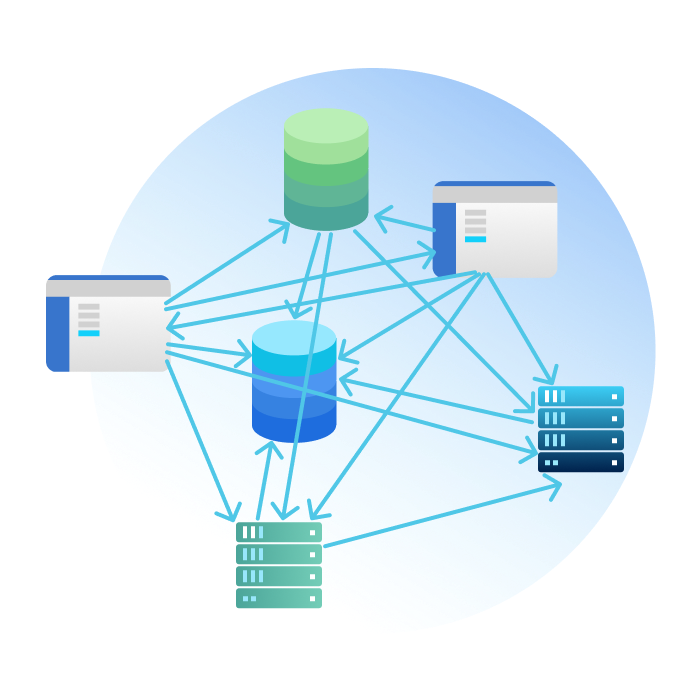Enterprise
The integration challenge
It starts by connecting two systems. What’s the harm? Before you know it, your integration architecture is a brittle mess of point-to-point connections that bog down your organization and create dependencies on vendor technology.
Integration as an afterthought
Your integration strategy should be focused on more than just implementing your critical systems. Start thinking about how those systems will connect in the future.


Point-to-point architecture
Two systems connected to each other is simple. That changes when there are 100 systems connected like this. Teams must tip-toe around brittle point-to-point architecture.

Platform creep
Vendor “integration platforms” are just proprietary interfaces for point-to-point integration. They produce a false sense of connectivity. In reality, they create vendor lock-in.


Resource constraints
Demand for IT project throughput steadily increases while resource budgets stay flat or diminish. IT teams find themselves playing a cruel and constant game of catch up.

Our delivery methodology

Agility layer
Implement an API agility layer to enable reuse and legacy modernization.

Integration platform
Leverage the integration platform that suits your needs, budget, and resources.
Best practices


API-led design
Build the agility layer with APIs that are modular, discoverable, and reusable.

Agile org model
Establish a new operating model to scale by building and leveraging reusable APIs.
Approach
Our collaborative approach leverages API-led and Agile best practices, building on insights derived from our most successful customers.

Discovery & planning
Understand your challenges, goals, and use cases, to align on a path forward.


Agile delivery
Organize and deliver the work following agile best practices.


Enablement & ownership
Progressively enable your team to become autonomous and take ownership of the solution.

Training and support
Jointly develop your training and support models.

 Enterprise Integration use cases
Enterprise Integration use cases
Modern integration is at the heart of our solutions. Below, are examples of enterprise integrations our team delivered leveraging reusable APIs that facilitate legacy modernization, faster development time, and increased throughput.
Workday with PeopleSoft
Implemented the MuleSoft Anypoint platform and followed the API-led approach to enable Workday as the management front-end using an existing PeopleSoft backend system of record. This resulted in the ability to assign students, faculty, and teachers to courseware, rooms, and other facilities for a major online education provider.

JD Edwards and JDA Software
Partnered with a major aircraft parts and supplies company to architect an integration platform between three manufacturing ERP systems. The design successfully integrated two legacy ERP systems, JDE and a home-grown system, with a new JDA Software ERP system.

Salesforce, Magento, JD Edwards and Darwin LIMS (Thermo Fisher)
Implemented the MuleSoft Anypoint platform and used the API-led approach to deliver two key use cases. The first was to integrate and coordinate incoming orders between Salesforce and Magento. The second was to enable health supplement inventory management in JD Edwards to reflect real-time laboratory quality test results from Darwin LIMS (Thermo Fisher).

NavRisk Vision, Chrome River Technologies, SAP, CitiBank/SWIFT
Designed and implemented an integration platform for a major American multinational oil and gas corporation to service multiple projects. These included automating and optimizing NavRisk Vision risk management system, Citibank/SWIFT, and other CMS, Federal, State, and Government regulatory entities. An additional project required integrating Chrome River expense management system with SAP.

Want to learn more? Start a conversation.


